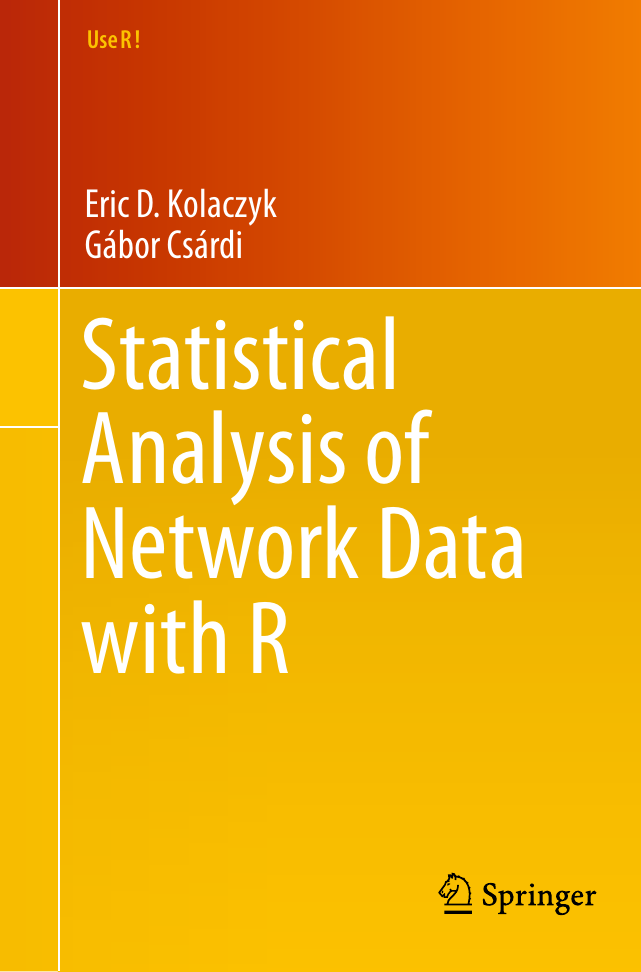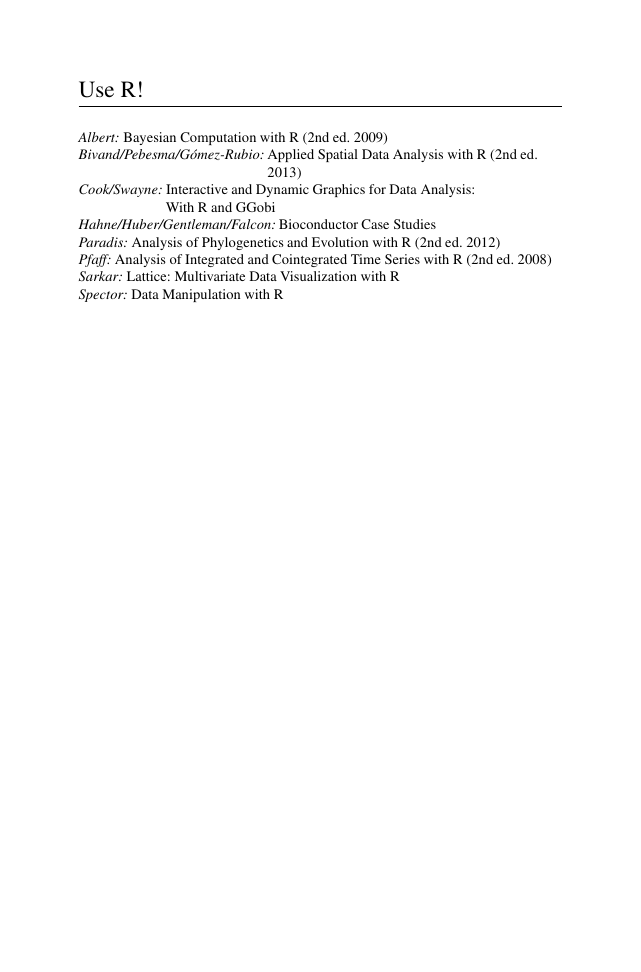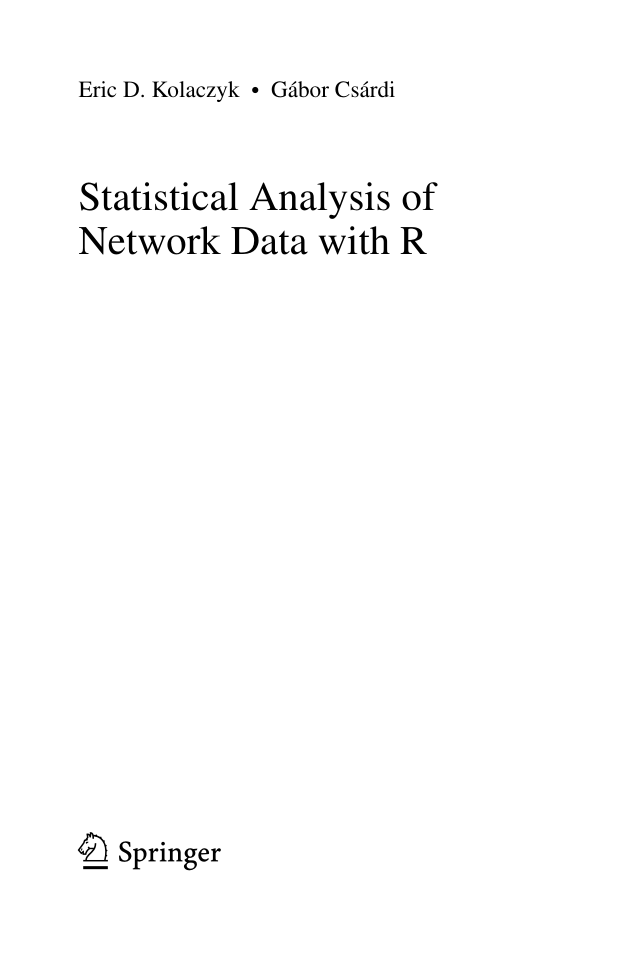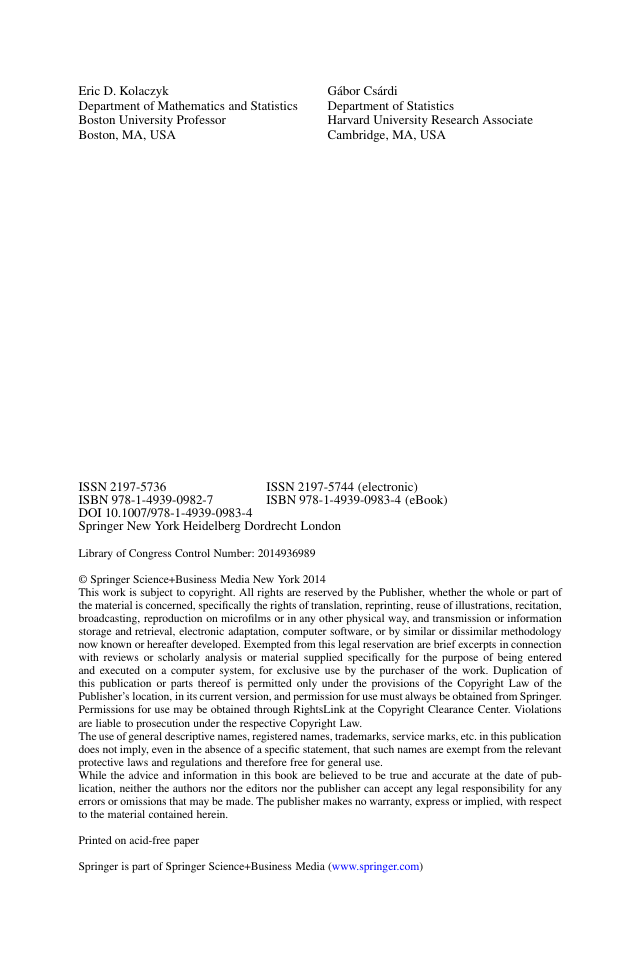Cover
Preface
Contents
Biographies
Chapter 1 Introduction
1.1 Why Networks?
1.2 Types of Network Analysis
1.2.1 Visualizing and Characterizing Networks
1.2.2 Network Modeling and Inference
1.2.3 Network Processes
1.3 Why Use R for Network Analysis?
1.4 About This Book
1.5 About the R code
Chapter 2 Manipulating Network Data
2.1 Introduction
2.2 Creating Network Graphs
2.2.1 Undirected and Directed Graphs
2.2.2 Representations for Graphs
2.2.3 Operations on Graphs
2.3 Decorating Network Graphs
2.3.1 Vertex, Edge, and Graph Attributes
2.3.2 Using Data Frames
2.4 Talking About Graphs
2.4.1 Basic Graph Concepts
2.4.2 Special Types of Graphs
2.5 Additional Reading
Chapter 3 Visualizing Network Data
3.1 Introduction
3.2 Elements of Graph Visualization
3.3 Graph Layouts
3.4 Decorating Graph Layouts
3.5 Visualizing Large Networks
3.6 Using Visualization Tools Outside of R
3.7 Additional Reading
Chapter 4 Descriptive Analysis of Network Graph Characteristics
4.1 Introduction
4.2 Vertex and Edge Characteristics
4.2.1 Vertex Degree
4.2.2 Vertex Centrality
4.2.3 Characterizing Edges
4.3 Characterizing Network Cohesion
4.3.1 Subgraphs and Censuses
4.3.2 Density and Related Notions of Relative Frequency
4.3.3 Connectivity, Cuts, and Flows
4.4 Graph Partitioning
4.4.1 Hierarchical Clustering
4.4.2 Spectral Partitioning
4.4.3 Validation of Graph Partitioning
4.5 Assortativity and Mixing
4.6 Additional Reading
Chapter 5 Mathematical Models for Network Graphs
5.1 Introduction
5.2 Classical Random Graph Models
5.3 Generalized Random Graph Models
5.4 Network Graph Models Based on Mechanisms
5.4.1 Small-World Models
5.4.2 Preferential Attachment Models
5.5 Assessing Significance of Network Graph Characteristics
5.5.1 Assessing the Number of Communities in a Network
5.5.2 Assessing Small World Properties
5.6 Additional Reading
Chapter 6 Statistical Models for Network Graphs
6.1 Introduction
6.2 Exponential Random Graph Models
6.2.1 General Formulation
6.2.2 Specifying a Model
6.2.3 Model Fitting
6.2.4 Goodness-of-Fit
6.3 Network Block Models
6.3.1 Model Specification
6.3.2 Model Fitting
6.3.3 Goodness-of-Fit
6.4 Latent Network Models
6.4.1 General Formulation
6.4.2 Specifying the Latent Effects
6.4.3 Model Fitting
6.4.4 Goodness-of-Fit
6.5 Additional Reading
Chapter 7 Network Topology Inference
7.1 Introduction
7.2 Link Prediction
7.3 Association Network Inference
7.3.1 Correlation Networks
7.3.2 Partial Correlation Networks
7.3.3 Gaussian Graphical Model Networks
7.4 Tomographic Network Topology Inference
7.4.1 Constraining the Problem: Tree Topologies
7.4.2 Tomographic Inference of Tree Topologies:An Illustration
7.5 Additional Reading
Chapter 8 Modeling and Prediction for Processes on Network Graphs
8.1 Introduction
8.2 Nearest Neighbor Methods
8.3 Markov Random Fields
8.3.1 General Characterization
8.3.2 Auto-Logistic Models
8.3.3 Inference and Prediction for Auto-logistic Models
8.3.4 Goodness of Fit
8.4 Kernel Methods
8.4.1 Designing Kernels on Graphs
8.4.2 Kernel Regression on Graphs
8.5 Modeling and Prediction for Dynamic Processes
8.5.1 Epidemic Processes: An Illustration
8.6 Additional Reading
Chapter 9 Analysis of Network Flow Data
9.1 Introduction
9.2 Modeling Network Flows: Gravity Models
9.2.1 Model Specification
9.2.2 Inference for Gravity Models
9.3 Predicting Network Flows: Traffic Matrix Estimation
9.3.1 An Ill-Posed Inverse Problem
9.3.2 The Tomogravity Method
9.4 Additional Reading
Chapter 10 Dynamic Networks
10.1 Introduction
10.2 Representation and Manipulation of Dynamic Networks
10.3 Visualization of Dynamic Networks
10.4 Characterization of Dynamic Networks
10.5 Modeling Dynamic Networks
References
Index
















 2023年江西萍乡中考道德与法治真题及答案.doc
2023年江西萍乡中考道德与法治真题及答案.doc 2012年重庆南川中考生物真题及答案.doc
2012年重庆南川中考生物真题及答案.doc 2013年江西师范大学地理学综合及文艺理论基础考研真题.doc
2013年江西师范大学地理学综合及文艺理论基础考研真题.doc 2020年四川甘孜小升初语文真题及答案I卷.doc
2020年四川甘孜小升初语文真题及答案I卷.doc 2020年注册岩土工程师专业基础考试真题及答案.doc
2020年注册岩土工程师专业基础考试真题及答案.doc 2023-2024学年福建省厦门市九年级上学期数学月考试题及答案.doc
2023-2024学年福建省厦门市九年级上学期数学月考试题及答案.doc 2021-2022学年辽宁省沈阳市大东区九年级上学期语文期末试题及答案.doc
2021-2022学年辽宁省沈阳市大东区九年级上学期语文期末试题及答案.doc 2022-2023学年北京东城区初三第一学期物理期末试卷及答案.doc
2022-2023学年北京东城区初三第一学期物理期末试卷及答案.doc 2018上半年江西教师资格初中地理学科知识与教学能力真题及答案.doc
2018上半年江西教师资格初中地理学科知识与教学能力真题及答案.doc 2012年河北国家公务员申论考试真题及答案-省级.doc
2012年河北国家公务员申论考试真题及答案-省级.doc 2020-2021学年江苏省扬州市江都区邵樊片九年级上学期数学第一次质量检测试题及答案.doc
2020-2021学年江苏省扬州市江都区邵樊片九年级上学期数学第一次质量检测试题及答案.doc 2022下半年黑龙江教师资格证中学综合素质真题及答案.doc
2022下半年黑龙江教师资格证中学综合素质真题及答案.doc